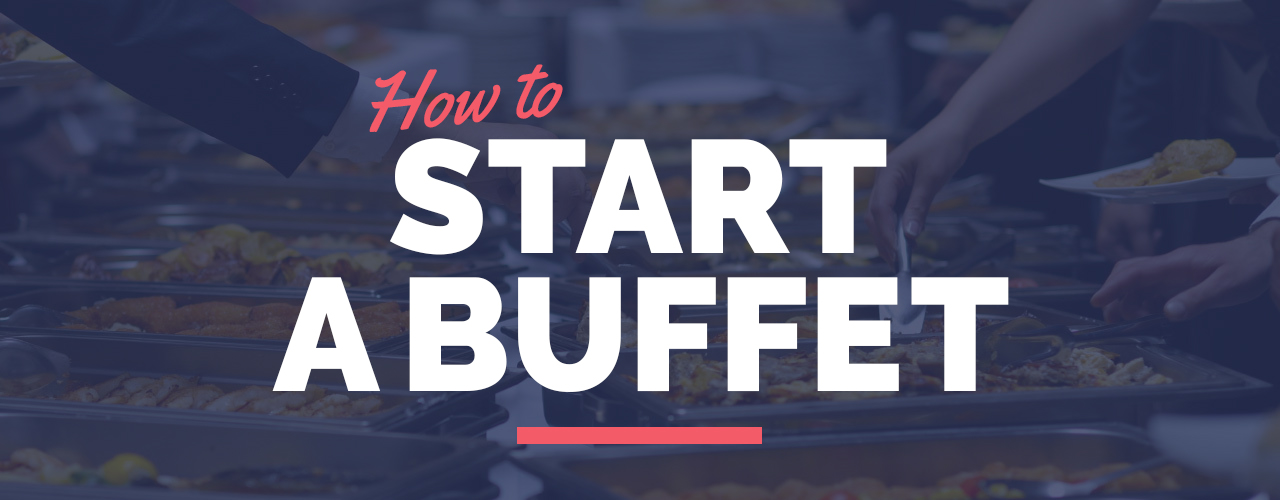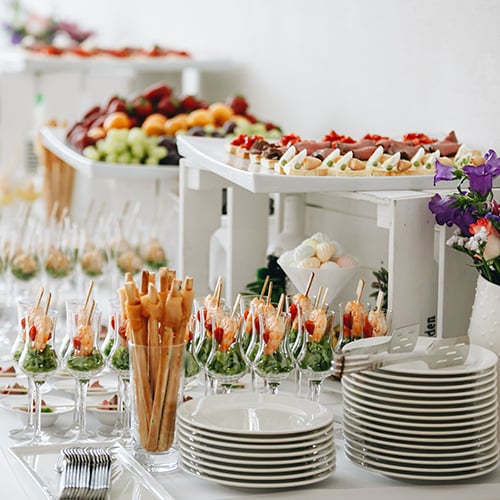
Buffets are a popular type of restaurant in the United States and can be found across the country in a variety of forms. The amount of food they need to produce presents many unique goals and challenges, differentiating them from other types of restaurants. As a result, there are some differences when opening a buffet as opposed to opening a traditional restaurant. Below, we'll break down everything you need to know about buffets, such as how they make money, the different types of buffets, and the steps you need to follow to open your own.
What Is a Buffet?
A buffet, also known as an “All You Can Eat” restaurant, is a type of restaurant where customers pay a fixed price to fill their plates with as much food as they’d like. Most buffets also have a theme that they use for their menus, such as buffets that specialize in barbecue or seafood. Furthermore, some buffets are affiliated with hotels, and this type of buffet is especially popular in Las Vegas or casinos.
Shop All Buffet SuppliesHow to Start a Buffet Restaurant
Starting a new restaurant can be difficult and time-consuming, especially if you're unfamiliar with the ins and outs of restaurant ownership. So, we've broken down opening a buffet restaurant into eight simple steps to guide you through the process.
1. Write a Buffet Restaurant Business Plan

The first step in opening any type of business is to create a solid business plan. A business plan lists important information about your potential business, such as a company overview, what food you'll serve, your location, market analysis, and financial projections. Your business plan not only gives you a guideline for opening your buffet, but it also can help you garner interest from potential investors or get loans from a bank.
There are seven main parts to a business plan that you should be sure to include:
- Executive summary: This is a one-to-four-page summary of your business and everything else in your business plan. It should be the last thing you write, although it will go at the front of your business plan.
- Company overview: Your overview should further develop the information in your executive summary and outline and answer questions like what your target audience and market niche is.
- Market analysis: The market analysis is where you break down the demographics in your target area and what your competition is in that area.
- Business offerings: This section is where you'll list out what type of food you'll be stocking your buffet with and where you'll be sourcing your ingredients.
- Management plan: Outline the management structure you're going to have and how many employees you'll need at your business.
- Marketing strategies: Explain to potential investors how you will market your restaurant, including advertising, coupon marketing, and grand opening discounts.
- Financial projections: Project your buffet's expenses and revenue using previous restaurant experience or through competitor analysis and market research.
2. Identify a Commercial Space
Once you've established the framework for your restaurant and you have investors, you can start looking for a space to lease. While some new restaurant owners may be tempted to buy a commercial space, we recommend leasing because it provides more flexibility in case you need to expand or have any business issues once your business is up and running.
When looking for a rental property for your buffet, you want to think about the demographics in a given area, and if they match your target demographic. You will also want to consider space for parking, if you can count on foot traffic, or if you're in a popular neighborhood.
Back to Top3. Apply for Permits and Licenses
There are various permits and licenses that new buffet restaurants need to obtain at the federal, state, and local levels before they begin operation. Some of these forms are very technical and can be hard to navigate, so it's best to have legal counsel help out when filing for restaurant permits and licenses to ensure that you complete everything correctly.
Additionally, if you're planning on serving alcohol at your buffet, there are other special licenses that you'll need to obtain.
Back to Top4. Determine What Equipment You'll Need

A lot of the equipment that you'll need in your kitchen will depend on what type of buffet you're opening and what specific recipes you'll be making. Still, there are a few pieces of equipment that every buffet will need. To make stocking your buffet's kitchen and dining space easy, we created a comprehensive list of the different types of equipment your buffet will need. Click the button below to find the downloadable PDF.
Download Equipment List PDFBack to Top
5. Decide on a Buffet Restaurant Layout
After you've decided on the layout for your kitchen and ordered all of your heavy equipment, you can focus on front-of-house areas and designing your dining space and actual buffet line. When choosing a design and layout for your dining space, you should consider the color scheme you're going to implement, how you're going to light the space, and what type of furniture you want to use.
Once you've decided on how many steam tables you'll need, you should decide how you're going to configure them and organize the dishes on your buffet. When designing the layout of your buffet, you should put your cost-effective and filling items, like vegetables and rice, at the front of the line, so customers fill their plates up with those before getting to the high-ticket items like seafood and meat.
Back to Top6. Hire a Staff
Hiring a competent staff is integral for ensuring your business is successful. If you don't already have someone in mind, the first person you should hire is an executive chef. The executive chef typically manages the cook staff and creates recipes to use in the buffet, so you must bring them on early in the process.
After finding your executive chef, you can look to hire a general manager, line cooks, wait staff, dishwashers, and other personnel. It's important to remember, though, that buffets can operate with a smaller wait staff since customers serve themselves. Additionally, once you've hired your staff, you need to keep them interested and invested in your restaurant to prevent employee turnover. Employee turnover is very common in the foodservice industry, but constantly hiring, training, and firing employees can end up draining your profits. Instead, invest in your employees and keep them happy by listening to their concerns and providing them with bonuses and perks.
Back to Top7. Advertise Your Buffet Restaurant

When your buffet is almost ready to open and your staff is trained, you need to advertise your business and get people in your area excited for your grand opening. There are many ways to advertise your business that don't involve showing advertisements on TV or buying ad space in the local newspaper. We've listed two of the most popular options below:
- Advertise on social media: Before you open your business, you should create accounts on all the major social media marketing sites, like Facebook, Twitter, and Instagram. This will allow you to interact with customers online after your business has opened, but before you open, you can use social media to get the word out about your new buffet restaurant and your grand opening. You can post in local groups on Facebook to notify people in your area or post images on Instagram of your food items to pique potential customers' interest.
- Use print advertising: An affordable way to promote your business is through outdoor advertising such as signs and flyers. If your new buffet restaurant is in a city or a prime location in town, signs announcing your opening date or that you're a new business are great ways to create interest among people walking or driving by. Another option would be to print out flyers that have information about your buffet and when it's opening, so guests have a physical reminder. If you use printed flyers, you may also want to add a coupon for a free drink or a slight discount for an added incentive.
Back to Top
8. Open Your Buffet Restaurant
The final step in opening a buffet restaurant is opening the buffet to the public. There are two main ways that you can open your business: a soft opening or a grand opening.
Hosting a Soft Opening
A soft opening is a test run of your business. It involves opening your restaurant to the public for a single night or dinner service. This will give your staff some experience and allow you to find any potential problems or weaknesses and get feedback from customers. After your soft opening, you can make adjustments to your service, menu, or atmosphere. Plus, if your soft opening goes well, you can build some excitement among customers for your grand opening.
Hosting a Grand Opening
After ironing out any issues with your service or menu, your buffet restaurant is ready to start hosting guests. A grand opening is also a great marketing opportunity, so you'll want to advertise your opening on your social media accounts or potentially reach out to local journalists and food bloggers.
Tips for Opening a Buffet
Here are some tips when opening your buffet to ensure that you get off to a good start:
- Pick a day strategically: Check online and make sure that there aren't any other events happening in your area on the same day as your opening.
- Advertise your opening at community events: For example, you can hand out samples at local farmers' markets or partner with a charitable organization and donate a percentage of your opening day profits.
- Offer coupons on opening day: One excellent way to create interest in your buffet and to bring in customers for your grand opening is to offer coupons and specials. For example, you can send out 10% off coupons or flyers for free drinks.
- Use signs and outdoor advertising: Adding outdoor signs to the sidewalk or in front of your business is a great way to notify people walking or driving by that your business is opening soon. Make sure to include the date and time of your grand opening so potential customers can add it to their schedules.
Back to Top
Types of Buffets

If you've decided that you want to open a buffet, you must choose a concept for your establishment and a theme for your food. There are many different types of buffets, but some are more popular and profitable than others. Here are some of the most popular types of buffets:
- Chinese buffets: Chinese buffets are one of the most popular types of buffets because they feature many different recipes. Furthermore, most Chinese buffets can be flexible with their pricing.
- Indian buffets: Another common type of buffet are Indian buffets. Buffets are crucial to Indian cuisine, and India is considered the originator of the all-you-can-eat buffet, which explains their prevalence. A benefit to opening an Indian restaurant is that some Indian dishes are very filling, so you can satisfy your customers with smaller portions, boosting your profits
- American buffets: This type of buffet is common in the United States, and many popular chains serve traditional American fare. They usually serve traditional American foods like french fries, fried chicken, steak, and roast turkey. These types of buffets are very popular with baby boomers and older crowds.
- Pizza buffets: Pizza buffets are an excellent choice because they offer endless recipe combinations and capitalize on one of the most popular foods in the world. Furthermore, you have the freedom to add foods such as soup, pasta, and salad to your menu to boost your profits and help fill up your customers.
- Sushi buffets: Sushi buffets can be difficult to execute well while remaining profitable due to the cost of sushi-grade fish and the difficulty in keeping sushi out on a buffet for long periods. But, this type of buffet can be very profitable, especially if you serve foods other than sushi, such as other Japanese foods.
How Do Buffets Make Money?

Because buffets have to produce so much food, you may be wondering how buffets make money. Staying profitable as a buffet owner involves cutting costs where possible, choosing ingredients carefully, and using psychology to structure your buffet's layout. Here are a couple of other examples of how buffets can make money:
- Food prep: Many buffets prepare their food in bulk, so they simply have to assemble the dishes before replenishing the buffet. As a result, buffets can operate with a smaller back-of-house team and lower their labor costs.
- Low overhead: Because customers serve themselves at buffets, you only need wait staff to bring drinks and clear tables. As a result, you can vastly reduce your front-of-house staff and cut down on overhead.
- Beverage markup: Most buffets don't include beverages in the price of the meal. Many buffets offer their drinks at 2-3 times the price of traditional restaurants, helping to boost their profits.
- Cutting down food costs: Buffets save on money, which leaves more money for profit, by reducing their food costs.
Tips to Increase Your Buffet's Profits
There are also a many clever tactics you can implement to help reduce food costs in your buffet and boost your profits. We've listed some of the most efficient tactics below:
- Use larger serving spoons for cost-efficient and filling dishes like rice and vegetables. Use smaller spoons or tongs at your protein stations, so customers take less food.
- Add a salad bar to your buffet. Some patrons will start their meal with a salad, soup, or bread, which will fill them up, so they have less room for your expensive dishes.
- Use smaller pans on your steam table. By using smaller pans, you're putting less food out at a time, but you're also minimizing waste, which helps reduce your food costs.
- Give your customers smaller plates, bowls, and silverware. If they have smaller dinnerware, they will have less space to fill up on food. And, the smaller silverware will cause them to eat more slowly, so they will get full faster.
- Track the items on your buffet and note which products are going quickly and which products are sitting and adjust accordingly. This will help prevent food waste.
- If you're planning on serving food like ham or turkey, create a carving station and place one of your chefs at it. That way you can control your portions and ensure that guests don't take too much.
Buffets can be profitable business ventures, but opening one requires a lot of planning and expertise. But, with some careful consideration, you can get your new buffet organized and outfitted. Additionally, if you have a strong business plan and strategy, it will help ensure that your business becomes profitable and successful.





